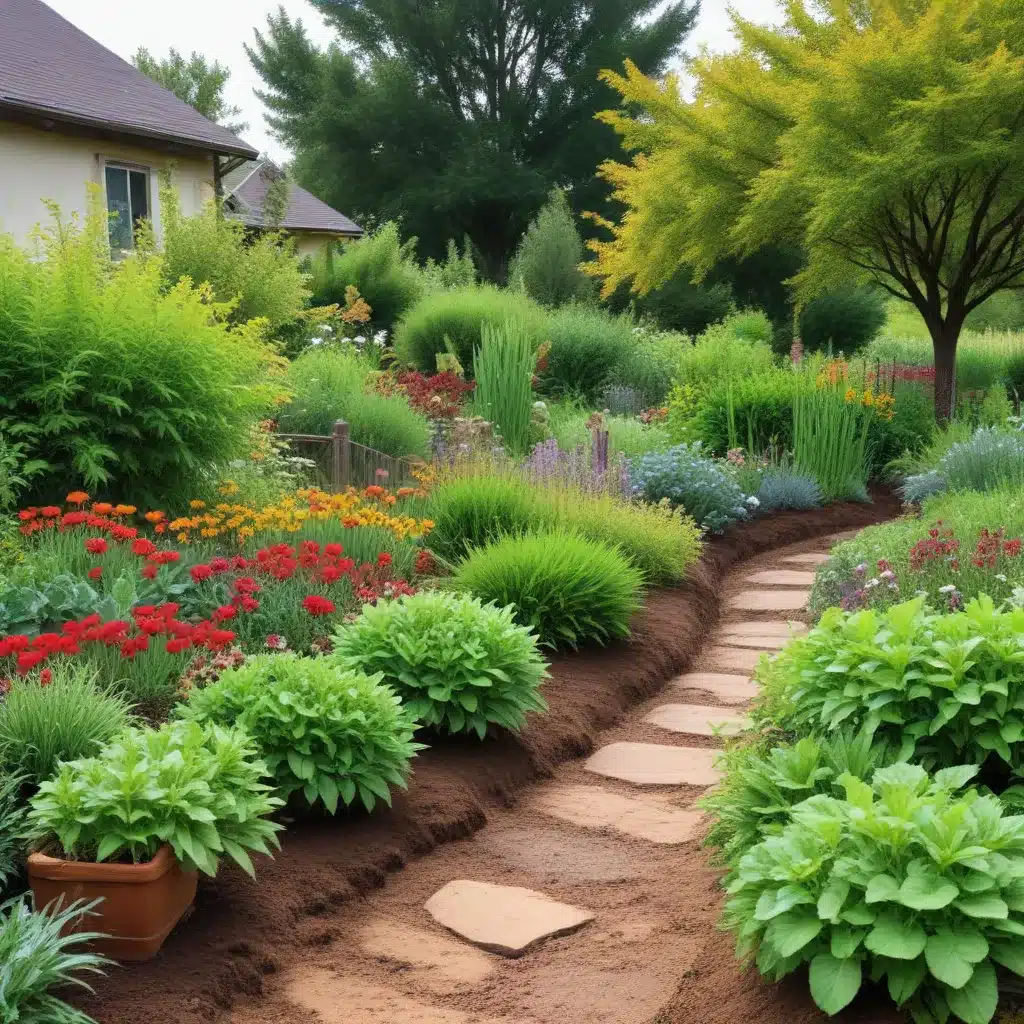
At Crooked Pines Farm, we believe that every garden has the power to become a thriving ecosystem – a living, breathing oasis that supports a diverse array of plant and animal life. By embracing biodiversity, we can create landscapes that not only delight the senses but also play a vital role in sustaining the natural world around us.
Ecological Balance
A biodiverse garden is a balanced garden. When you cultivate a variety of native plants, you create a complex web of interdependencies that allow an entire ecosystem to flourish. Each species has a role to play, from the pollinators that fertilize your fruits and vegetables to the soil microbes that enrich the earth. By fostering this natural equilibrium, you reduce the need for costly and environmentally harmful inputs like pesticides and synthetic fertilizers.
Pest and Disease Resistance
Monocultures – landscapes dominated by a single plant species – are vulnerable to pest infestations and disease outbreaks. But in a diverse garden, pests have a harder time gaining a foothold. Beneficial insects like ladybugs and lacewings can effectively manage populations of aphids, caterpillars, and other garden pests. And the resilience of your plants increases when they’re surrounded by a variety of companions that can share resources and defend against threats.
Improved Soil Health
Healthy soil is the foundation of any thriving garden, and biodiversity plays a crucial role in its development. Native plants have evolved intricate relationships with the microorganisms, fungi, and creatures that live in the soil. Their deep, sprawling root systems help build soil structure, while the fallen leaves and organic matter they contribute enrich the earth with vital nutrients. By incorporating diverse plantings, you’re investing in the long-term fertility of your soil.
Designing a Diverse Garden Layout
Creating a biodiverse garden starts with a thoughtful design process. Begin by assessing your site, taking note of the sun exposure, moisture levels, and existing landscape features. This information will guide you in selecting the right plants and positioning them for maximum impact.
Site Assessment and Planning
Walk your property and make observations: Where do you have sunny, shady, or moist areas? Are there any slopes, barriers, or existing plantings to work around? Mapping out these details will help you visualize how to arrange your garden for optimal diversity.
Selecting Appropriate Plant Varieties
When it comes to choosing plants, diversity is key. Aim to incorporate a mix of native trees, shrubs, perennials, and annuals that provide food and shelter for a variety of beneficial organisms. Research which species are well-suited to your local climate and soil conditions.
Incorporating Habitat Elements
In addition to the plants themselves, include features that create diverse microclimates and shelter for wildlife. Consider adding a birdbath, rock pile, or small pond to provide water sources. Leaving some areas of leaf litter or dead wood can also invite insects, amphibians, and small mammals to make your garden their home.
Cultivating Native Plants
At the heart of a biodiverse garden are the native plants that have co-evolved with the local ecosystem over thousands of years. These species are uniquely adapted to thrive in your specific growing conditions and support the greatest number of native insects, birds, and other wildlife.
Identifying Native Species
Consult regional plant guides or reach out to your local cooperative extension office to determine which native plants are best suited for your area. Look for species that are endemic to your region, as they will be the most beneficial to your local ecosystem.
Propagating and Establishing Native Plants
Many native plants can be easily grown from seed, allowing you to affordably establish a diverse range of species. Be patient, as some natives may take longer to germinate and establish compared to more common ornamentals. Proper site preparation and mulching are also key to helping your native plants thrive.
Maintaining Native Plant Communities
Once your native plants are in the ground, resist the urge to “tidy up” your garden too much. Allow fallen leaves and stems to decompose naturally, providing essential habitat and nutrient cycling. Periodic prescribed burns or mowing can also help maintain the health of native grassland and prairie plants.
Attracting Pollinators and Wildlife
Pollinators like bees, butterflies, and hummingbirds are the lifeblood of a biodiverse garden. By creating an environment that caters to their needs, you’ll not only enjoy their beautiful presence but also ensure the successful pollination of your fruits, vegetables, and flowers.
Pollinator-Friendly Plantings
Choose a diverse array of nectar-rich and pollen-producing plants that bloom at different times of the year. This ensures a consistent food source for pollinators throughout the growing season. Also, incorporate host plants like milkweed that provide critical breeding and egg-laying sites for species like monarchs.
Creating Shelter and Water Sources
In addition to food, pollinators and other wildlife need places to rest, nest, and drink. Incorporate features like hollow stems, rock piles, and small water features to offer these vital resources. Leaving sections of your garden “wild” with untrimmed vegetation can also provide valuable shelter.
Minimizing Pesticide Use
Pesticides, even organic ones, can have detrimental effects on beneficial insects and other wildlife. Instead, explore integrated pest management (IPM) strategies that focus on prevention, natural deterrents, and targeted treatments when necessary. The health of your entire ecosystem depends on reducing these chemical inputs.
Sustainable Gardening Practices
Maintaining a biodiverse garden requires a commitment to sustainability. By embracing practices that nurture the soil, conserve resources, and work in harmony with nature, you’ll ensure the long-term viability of your outdoor oasis.
Composting and Mulching
Composting is a cornerstone of sustainable gardening, transforming food scraps and yard waste into nutrient-rich soil amendments. Topping your garden beds with organic mulch also helps retain moisture, suppress weeds, and gradually improve soil structure.
Water Conservation Techniques
Water is a precious resource, so implement strategies to minimize usage while still maintaining a thriving garden. Consider installing rain barrels, using drip irrigation, and selecting drought-tolerant native plants that can better withstand dry spells.
Integrated Pest Management
Rather than relying on broad-spectrum pesticides, adopt an IPM approach that combines cultural, mechanical, and biological controls. This holistic method focuses on preventing pest problems before they arise, using the least-toxic interventions only when absolutely necessary.
Incorporating Edible Landscaping
Biodiversity and food production don’t have to be mutually exclusive. By thoughtfully incorporating edible plants into your garden design, you can enjoy the best of both worlds – a visually stunning landscape that also provides nourishment for you and your family.
Integrating Fruit and Vegetable Plants
Mix fruit trees, berry bushes, and vegetable beds seamlessly into your ornamental plantings. Choose compact, high-yielding cultivars that fit harmoniously within your overall design.
Companion Planting Strategies
Pair your edible plants with companion species that offer benefits like pest deterrence, soil improvement, and increased pollination. This companion planting approach mimics the natural symbiosis found in diverse ecosystems.
Preserving Harvests
Take advantage of your garden’s bounty by learning techniques for canning, dehydrating, and freezing your fresh produce. This allows you to enjoy the flavors of your homestead throughout the year, minimizing food waste.
Monitoring and Evaluating Success
Maintaining a thriving, biodiverse garden is an ongoing process of observation, experimentation, and adaptation. By regularly monitoring the ebb and flow of life in your landscape, you can fine-tune your management strategies and celebrate the many successes along the way.
Observing Ecosystem Interactions
Become a keen observer of the insects, birds, and other creatures that make your garden their home. Take note of which plants they’re attracted to, how their populations fluctuate, and any changes you notice in the overall health of your ecosystem.
Collecting Biodiversity Data
Consider participating in citizen science initiatives like the Homegrown National Park project, which allows you to contribute valuable data on the plant and animal species found in your backyard. This information can help you measure the impact of your gardening efforts over time.
Adjusting Management Strategies
As you observe your garden’s evolution, be willing to make adjustments to your planting choices, maintenance routines, and other management practices. Remain flexible and open to trying new techniques that can further enhance the biodiversity and resilience of your landscape.
At Crooked Pines Farm, we believe that every gardener has the power to create a sanctuary for life. By embracing biodiversity and adopting sustainable gardening practices, you can transform your outdoor space into a thriving ecosystem that benefits both you and the natural world around you. So, let’s get planting, and watch as your garden comes alive with the sights, sounds, and vibrant energy of a truly diverse and resilient landscape.


